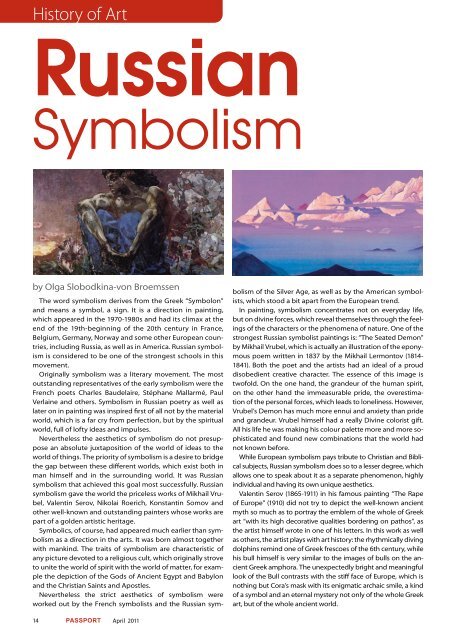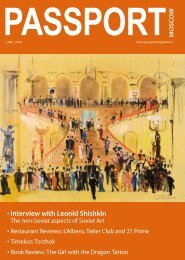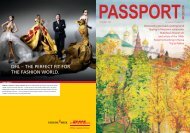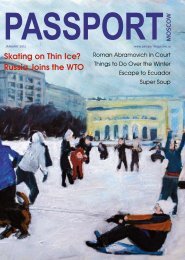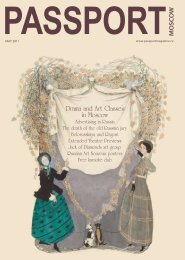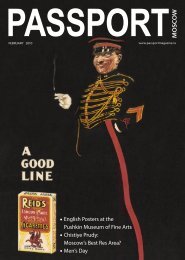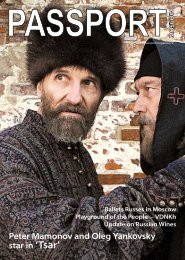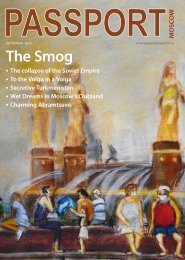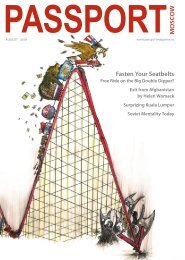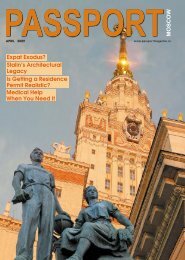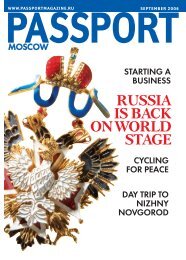Feminism in Russia - Passport magazine
Feminism in Russia - Passport magazine
Feminism in Russia - Passport magazine
You also want an ePaper? Increase the reach of your titles
YUMPU automatically turns print PDFs into web optimized ePapers that Google loves.
History of Art<br />
<strong>Russia</strong>n<br />
Symbolism<br />
by Olga Slobodk<strong>in</strong>a-von Broemssen<br />
The word symbolism derives from the Greek “Symbolon”<br />
and means a symbol, a sign. It is a direction <strong>in</strong> pa<strong>in</strong>t<strong>in</strong>g,<br />
which appeared <strong>in</strong> the 1970-1980s and had its climax at the<br />
end of the 19th-beg<strong>in</strong>n<strong>in</strong>g of the 20th century <strong>in</strong> France,<br />
Belgium, Germany, Norway and some other European countries,<br />
<strong>in</strong>clud<strong>in</strong>g <strong>Russia</strong>, as well as <strong>in</strong> America. <strong>Russia</strong>n symbolism<br />
is considered to be one of the strongest schools <strong>in</strong> this<br />
movement.<br />
Orig<strong>in</strong>ally symbolism was a literary movement. The most<br />
outstand<strong>in</strong>g representatives of the early symbolism were the<br />
French poets Charles Baudelaire, Stéphane Mallarmé, Paul<br />
Verla<strong>in</strong>e and others. Symbolism <strong>in</strong> <strong>Russia</strong>n poetry as well as<br />
later on <strong>in</strong> pa<strong>in</strong>t<strong>in</strong>g was <strong>in</strong>spired first of all not by the material<br />
world, which is a far cry from perfection, but by the spiritual<br />
world, full of lofty ideas and impulses.<br />
Nevertheless the aesthetics of symbolism do not presuppose<br />
an absolute juxtaposition of the world of ideas to the<br />
world of th<strong>in</strong>gs. The priority of symbolism is a desire to bridge<br />
the gap between these different worlds, which exist both <strong>in</strong><br />
man himself and <strong>in</strong> the surround<strong>in</strong>g world. It was <strong>Russia</strong>n<br />
symbolism that achieved this goal most successfully. <strong>Russia</strong>n<br />
symbolism gave the world the priceless works of Mikhail Vrubel,<br />
Valent<strong>in</strong> Serov, Nikolai Roerich, Konstant<strong>in</strong> Somov and<br />
other well-known and outstand<strong>in</strong>g pa<strong>in</strong>ters whose works are<br />
part of a golden artistic heritage.<br />
Symbolics, of course, had appeared much earlier than symbolism<br />
as a direction <strong>in</strong> the arts. It was born almost together<br />
with mank<strong>in</strong>d. The traits of symbolism are characteristic of<br />
any picture devoted to a religious cult, which orig<strong>in</strong>ally strove<br />
to unite the world of spirit with the world of matter, for example<br />
the depiction of the Gods of Ancient Egypt and Babylon<br />
and the Christian Sa<strong>in</strong>ts and Apostles.<br />
Nevertheless the strict aesthetics of symbolism were<br />
worked out by the French symbolists and the <strong>Russia</strong>n sym-<br />
1 April 2011<br />
bolism of the Silver Age, as well as by the American symbolists,<br />
which stood a bit apart from the European trend.<br />
In pa<strong>in</strong>t<strong>in</strong>g, symbolism concentrates not on everyday life,<br />
but on div<strong>in</strong>e forces, which reveal themselves through the feel<strong>in</strong>gs<br />
of the characters or the phenomena of nature. One of the<br />
strongest <strong>Russia</strong>n symbolist pa<strong>in</strong>t<strong>in</strong>gs is: “The Seated Demon”<br />
by Mikhail Vrubel, which is actually an illustration of the eponymous<br />
poem written <strong>in</strong> 1837 by the Mikhail Lermontov (1814-<br />
1841). Both the poet and the artists had an ideal of a proud<br />
disobedient creative character. The essence of this image is<br />
twofold. On the one hand, the grandeur of the human spirit,<br />
on the other hand the immeasurable pride, the overestimation<br />
of the personal forces, which leads to lonel<strong>in</strong>ess. However,<br />
Vrubel’s Demon has much more ennui and anxiety than pride<br />
and grandeur. Vrubel himself had a really Div<strong>in</strong>e colorist gift.<br />
All his life he was mak<strong>in</strong>g his colour palette more and more sophisticated<br />
and found new comb<strong>in</strong>ations that the world had<br />
not known before.<br />
While European symbolism pays tribute to Christian and Biblical<br />
subjects, <strong>Russia</strong>n symbolism does so to a lesser degree, which<br />
allows one to speak about it as a separate phenomenon, highly<br />
<strong>in</strong>dividual and hav<strong>in</strong>g its own unique aesthetics.<br />
Valent<strong>in</strong> Serov (1865-1911) <strong>in</strong> his famous pa<strong>in</strong>t<strong>in</strong>g “The Rape<br />
of Europe” (1910) did not try to depict the well-known ancient<br />
myth so much as to portray the emblem of the whole of Greek<br />
art “with its high decorative qualities border<strong>in</strong>g on pathos”, as<br />
the artist himself wrote <strong>in</strong> one of his letters. In this work as well<br />
as others, the artist plays with art history: the rhythmically div<strong>in</strong>g<br />
dolph<strong>in</strong>s rem<strong>in</strong>d one of Greek frescoes of the 6th century, while<br />
his bull himself is very similar to the images of bulls on the ancient<br />
Greek amphora. The unexpectedly bright and mean<strong>in</strong>gful<br />
look of the Bull contrasts with the stiff face of Europe, which is<br />
noth<strong>in</strong>g but Cora’s mask with its enigmatic archaic smile, a k<strong>in</strong>d<br />
of a symbol and an eternal mystery not only of the whole Greek<br />
art, but of the whole ancient world.


